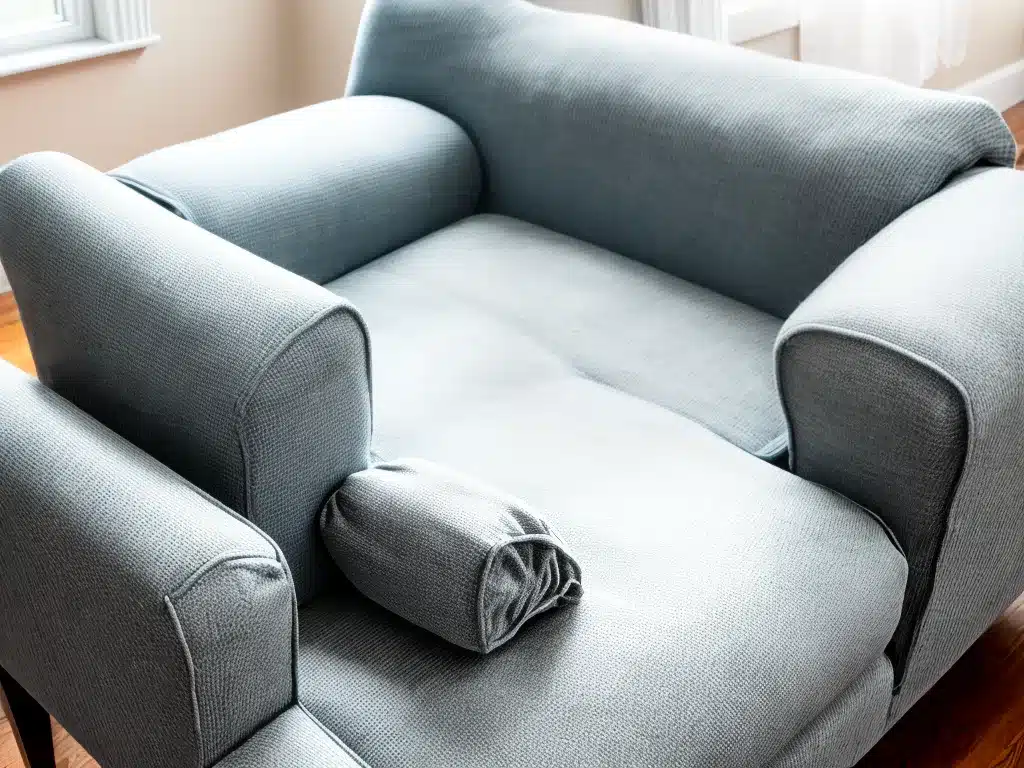Introduction
Keeping your sofa and chairs looking fresh and clean can seem like an uphill battle. Spills, pet hair, and everyday wear and tear can make fabric upholstery look dingy and dated. While professional upholstery cleaning services can help, they can be expensive and inconvenient. Luckily, there are several DIY methods you can use to clean and refresh your sofa and chairs right at home.
I’ve used various DIY upholstery cleaning techniques over the years to save money and breathe new life into old furniture. In this article, I’ll share everything I’ve learned about effectively cleaning upholstery yourself. From vacuuming and spot cleaning to deep cleaning methods using gentle soap, water, and steam, you’ll learn all the tips and tricks to make your sofa and chairs look like new again.
Vacuum Thoroughly
The first step in any upholstery cleaning project should be vacuuming. Thorough vacuuming helps remove loose dirt, dust, pet hair, crumbs, and other debris that accumulates on the surface of the fabric.
Use an upholstery attachment or soft brush attachment on your vacuum. Carefully vacuum all surfaces of the sofa or chair – the seat, back, arms, and bottom/base areas. Take your time and vacuum slowly to lift up as much dirt and hair as possible.
Vacuuming first makes any subsequent cleaning steps more effective since you are removing surface particles rather than just spreading them around. It also helps freshen the upholstery by lifting away odors that can get trapped in the fabric.
Spot Clean Stains and High-Traffic Areas
Once you’ve thoroughly vacuumed, inspect the upholstery for any visible stains or especially dirty high-traffic areas. Spot clean these areas with a small amount of mild upholstery cleaner or a gentle soap and water solution.
For liquid stains like wine or coffee, blot the stain gently with a clean cloth to soak up as much as possible. Mix a solution of warm water and mild soap or use an upholstery cleaner. Dampen a soft cloth with the solution and gently dab the stain. Avoid vigorously rubbing as this can further spread the stain and damage the fabric.
For greasy stains, sprinkle some baking soda over the spot and let sit for a few hours before vacuuming. For mud or dirt stains, let the mud fully dry first and then vacuum thoroughly before using a cleaning solution.
Areas where hands and heads frequently touch like armrests and top cushions also tend to get dirtier faster. Spot clean these high-traffic zones to freshen them up between deeper cleanings.
Deep Clean with Upholstery Shampoo
For a deeper clean to refresh the entire surface, use an upholstery shampoo and water method. This is gentler than steam cleaning but lifts away more grime than just vacuuming and spot cleaning.
Mix an upholstery or carpet shampoo concentrate with warm water in a bucket according to label directions. Use a soft brush or scrubbing sponge to work the shampoo solution into the fabric. Avoid oversaturating the upholstery – work in sections and use a clean cloth to blot and rinse each section after scrubbing.
Let the fabric fully dry and then vacuum again to lift away excess cleaning residue. This method can be used on both removable upholstery covers as well as directly on upholstered furniture.
Steam Clean for a Deep Refresh
For the most thorough DIY cleaning, use a handheld steam cleaner on your upholstery. The combination of hot steam and cleaning solution helps sanitize and freshen the fabric, lifting away deep-set grime.
Always check the upholstery tag before steaming – some very delicate fabrics like silk should not be steam cleaned. For most upholstery fabrics, use the steam cleaner with a small amount of mild upholstery detergent in the reservoir.
Work in sections, holding the steam head about an inch above the fabric surface. The steam and soap mixture will loosen and dissolve dirt and stains. Use a clean absorbent towel to blot the area after steaming to soak up the dirt.
Finish with Fabric Protection
Once your upholstery is freshly cleaned, consider applying a fabric protector spray. These sprays provide an invisible barrier against future stains and dirt. Choose a spray that is specifically formulated for home furnishings and upholstery rather than carpets.
Shake the can well and hold 6-8 inches from the fabric to lightly mist a thin layer over all surfaces. This helps locked in the fresh clean look and makes future cleanings easier. Reapply every 6 months or as needed.
Conclusion
With the right methods and a little elbow grease, you can give your sofa, chairs, and other upholstered pieces a deep clean refresh right at home. Regular vacuuming paired with periodic deep cleaning will keep your furniture looking its best. Spot clean stains right away to prevent them from setting.
With this complete guide to DIY upholstery cleaning techniques, you can keep your furniture fresh between professional cleaning appointments or choose to thoroughly clean it yourself and save money. Get started today and breathe new life into your upholstered sofa, chairs, ottomans, cushions and more.







